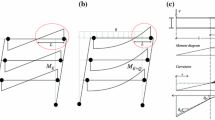Abstract
In this paper, three new performance indices are proposed which can be used in order to determine the global performance of a given structure. The ASCE41-13 standard and the FEMA350 guidelines are used as representatives of, respectively, an element-oriented and a system-oriented performance-based assessment algorithm. Two ten-storeyed special steel moment frames, consisting of a regular and an irregular structure, are designed and assessed using these two algorithms. The results show that the element-oriented assessment algorithm significantly underestimates the seismic demand and capacity, especially in the case of the immediate occupancy and collapse prevention limit states. This underestimation can cause a significant drop in the estimated confidence levels.















Similar content being viewed by others
References
AISC (2010) Specification for structural steel buildings. ANSI/AISC 360-10, Chicago
ASCE (2007) Seismic rehabilitation of existing buildings. ASCE/SEI 41-06, Reston, VA
ASCE (2010) Minimum design loads for buildings and other structures. ASCE/SEI 7-10, Reston, VA
ASCE/SEI (Structural Engineering Institute) (2014) Seismic evaluation and retrofit of existing buildings. ASCE/SEI 41-13, Reston, VA
Asgarian B, Sadrinezhad A, Alanjari P (2010) Seismic performance evaluation of steel moment resisting frames through incremental dynamic analysis. J Constr Steel Res 66(2):178–190
Azarbakht A, Dolšek M (2011) Progressive incremental dynamic analysis for first-mode dominated structures. J Struct Eng 137:445–455. https://doi.org/10.1061/(ASCE)ST.1943-541X.0000282
Bozorgnia Y, Bertero VV (eds) (2004) Earthquake engineering. CRC Press, New York
Chopra AK (1995) Dynamics of structures: theory and applications to earthquake engineering. Prentice-Hall. Inc., Upper Saddle River
Cornell CA, Jalayer F, Hamburger RO, Foutch DA (2002) The probabilistic basis for the 2000 SAC/FEMA steel moment frame guidelines. ASCE J Struct Eng 128(4):526–533
Dolsek M (2009) Incremental dynamic analysis with consideration of modeling uncertainties. Earthq Eng Struct Dyn 38(6):805–825
FEMA (2000a) Prestandard and commentary for the seismic rehabilitation of buildings. FEMA-356, Washington, DC
FEMA (2000b) Recommended seismic design criteria for new steel moment frame buildings. Report No. FEMA-350, SAC Joint Venture, Federal Emergency Management Agency, Washington, DC
FEMA (2009) Quantification of building seismic performance factors. Rep. FEMA-P695, FEMA, Washington, DC
Gilton C, Chi B, Uang CM (2000) Cyclic testing of a free flange moment connection. SAC/BD-00/19, SAC Joint Venture, Sacramento, CA
Han WW, Chopra AK (2006) Approximate incremental dynamic analysis using the modal pushover analysis procedure. Earthq Eng Struct Dyn 35(15):1853–1873
Ibarra LF, Krawinkler H (2005) Global collapse of frame structures under seismic excitations. Report No. TB 152, The John A. Blume Earthquake Engineering Center, Stanford Univ., Stanford, CA
Lee K, Foutch DA (2000) Performance prediction and evaluation of steel special moment frames for seismic loads. SAC Background Document SAC/BD-00/25, SAC Joint Venture, Richmond, CA
Lee K-H, Stojadinovic B, Goel SC, Margarian AG, Choi J, Wongkaew A, Reyher B P, Lee D-Y (2000) Parametric tests on unreinforced connections. SAC Background Document SAC/BD-00/01, SAC Joint Venture, Richmond, CA
Liu J, Astaneh-Asl A (2000) Cyclic tests on simple connections including effects of the slab. SAC Background Document SAC/BD-00/03, SAC Joint Venture, Richmond, CA
Mazzoni S, McKenna F, Scott MH, Fenves GL (2006) OpenSees command language manual. Pacific Earthquake Engineering Research (PEER) Center 264
Trifunac MD, Brady AG (1975) A study on the duration of strong earthquake ground motion. Bull Seismol Soc Am 65(3):581–626
USACE (U.S. Army Corps of Engineers) (2007) Earthquake design and evaluation of concrete hydraulic structures. Report No. EM 1110-2-6053, Dept. of the Army, Washington, DC
Vamvatsikos D, Cornell CA (2002) Incremental dynamic analysis. Earthq Eng Struct Dyn 31(3):491–514
Vamvatsikos D, Cornell CA (2004) Applied incremental dynamic analysis. Earthq Spectra 20(2):523–553
Vamvatsikos D, Cornell CA (2005) Direct estimation of seismic demand and capacity of multidegree-of-freedom systems through incremental dynamic analysis of single degree of freedom approximation. J Struct Eng 131:589–599. https://doi.org/10.1061/(ASCE)0733-9445(2005)131:4(589)
Vamvatsikos D, Fragiadakis M (2010) Incremental dynamic analysis for estimating seismic performance sensitivity and uncertainty. Earthq Eng Struct Dyn 39(2):141–163
Venti M, Engelhardt MD (2000) Test of a free flange connection with a composite floor slab. SAC Background Document SAC/BD-00/18, SAC Joint Venture, Richmond, CA
Author information
Authors and Affiliations
Corresponding author
Rights and permissions
About this article
Cite this article
Fadaei, E., Shakib, H. & Azarbakht, A. Structural Global Performance Assessment Versus Individual Element-Oriented Performance-Based Assessment. Iran J Sci Technol Trans Civ Eng 44 (Suppl 1), 141–150 (2020). https://doi.org/10.1007/s40996-020-00379-9
Received:
Accepted:
Published:
Issue Date:
DOI: https://doi.org/10.1007/s40996-020-00379-9




